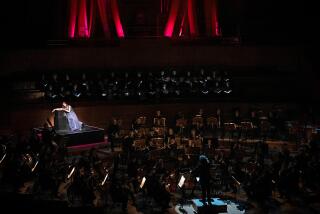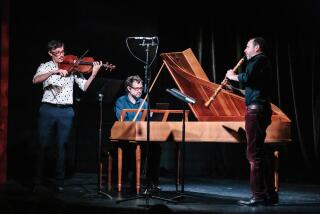MUSIC REVIEW : The Camerata Honors Saint
- Share via
IRVINE — Perhaps St. Cecilia listened and was touched by the celebration given in her honor Saturday night by the Irvine Camerata. The patron saint of music and musicians certainly could not have asked for a more refined remembrance than the understated gala led by Robert Hickok at the Irvine Barclay Theatre.
Festivities revolved around music by Henry Purcell, with two of his four odes for the saint’s day--”Welcome to All the Pleasures” and “Hail! Bright Cecilia”--as well as a birthday ode actually intended for Queen Mary--”Come Ye Sons of Art.” “Hail! Bright Cecilia” stood apart as the most ambitious and the most polished of the offerings.
Here, the 20-member orchestra that had begun the program mired in tenuousness, with ragged entrances and little attention to chromaticisms, came together in the opening symphony in well-defined imitation and a bleatingly plaintive adagio. Dialogue between the strings and a trio formed by Alfred Lang, Karen Tkaczyk and Danielle Squyres on trumpets and timpani created attractively lively allegros. Continuous work by Malcolm Hamilton on harpsichord and Ian McKinnel on cello remained unerringly rhythmic, stylish and attentive throughout.
Vocal soloists proved uneven in natural prowess, though not jarringly mismatched. Countertenors Drew Minter and Brian Asawa shone through pristine, elegant projection. Minter, especially, illuminated “Tis nature’s voice” with unusually free tone and control of dynamics, vibrato and enunciation. He conveyed the text with sympathetic flexibility and formed a flawlessly matched blend with tenor Bruce Johnson for “In vain the am’rous flute and soft guitar.”
Earl Patriarco brought clear sonority and straightforward reading to “Wondrous machine” and outstripped his fellow baritone Bruce Bales in consistency of tone during register changes in “Let these among themselves contest.” Soprano Linda Williams lent her small, unremarkable instrument to a bland “Thou tun’st this world below,” which was nevertheless enlivened by oboists Joseph Stone and Laura Stone.
The Camerata gave balanced and sensitive support to featured vocalists during Purcell’s works but were given the spotlight primarily in Benjamin Britten’s “Hymn to St. Cecilia.” Under Hickok’s economical direction, choristers shaped lines with precise accentuation and well-trained mastery of dynamics. In louder sections, balance fell to the male voices, but in lighter portions--such as “I cannot grow”--the choir reacted with busy, clipped clarity.
More to Read
The biggest entertainment stories
Get our big stories about Hollywood, film, television, music, arts, culture and more right in your inbox as soon as they publish.
You may occasionally receive promotional content from the Los Angeles Times.










